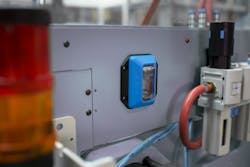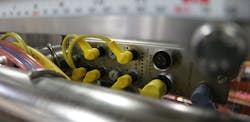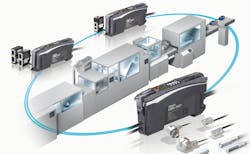If industrial control systems are the brains of a plant, then sensors are its eyes and ears. Simply put, without sensors there would be nothing for SCADA, DCS, or PLCs to respond to. That’s why increasingly intelligent or “smart” sensors packing more onboard processing power, the ability to monitor new variables, and digital communication capabilities are playing such an important role in helping plant operators and enterprise level planners alike to see better and respond to problems with more finesse.
In the past, sensors were largely relegated to the status of mere on-off switches. When inputs such as temperature, flow, or proximity pass a certain threshold, an analog sensor sends out a current or voltage signal to set a simple control loop into action. For instance, fans could speed up or slow down, control valves might change position, or bumpers on a conveyor may be actuated.
Today’s smart sensors, however, are different in a number of ways, says Manikandan Nambiar, vice president of product management for Plantweb and reliability solutions at Emerson Automation Solutions. Most importantly, many contain micro electro-mechanical systems (MEMS) along with onboard microcontrollers, which allow them to collect and process more information in real-time.
The use of this technology in modern sensors reflects two major trends at play: The first is “sensor fusion,” or the ability for a single sensor to monitor multiple input types, leading not only to more granular insights, but cost efficiencies as well. In essence, more data can be attained without needing to invest in multiple devices. Secondly, the capacity to track how inputs are changing over time may allow maintenance personnel and others to move from engaging in a merely reactive approach—that is, responding to a problem when an on-off switch is tripped—to truly understanding the root cause of a failure and moving to prevent it from happening again.
“There’s a lot of different ways to define a smart sensor, depending on the type you’re talking about; but in my mind, where the smarts really come in is with these MEMS along with the microcontrollers,” says Christopher Koch, senior application engineer for connected devices and solutions at Bosch Rexroth. “When you add these components, you can have sensors that have accelerometers, gyroscopes, and magnetometers all combined into one; or environmental sensors that have temperature, pressure, and humidity all together. Then you have the ability to communicate that data into upstream analytics sites. That’s really what a smart sensing device is.”
Communication protocols and network architecture
The evolution of smart sensing technology to its current state has been a long time coming. The edge computing power present in modern sensors is largely the result of Moore’s Law (the observation that the number of transistors in an integrated circuit doubles every two years), yielding exponential growth in processing power and fueling the endless array of ever-smaller devices we continue to make use of.
However, smart sensors didn’t develop in a vacuum, and their value can’t be fully tapped in one either. According to Balluff marketing manager Shishir Rege, numerous communication protocols and network architecture complexities have often hampered their deployment. Just as sense organs are of little use without the neural pathways that carry the information they gather to the brain, smart sensors with no effective means of communication are little more than expensive hunks of circuitry. Solving these problems over the past decade has greatly accelerated new sensor adoption and will continue to do so.
While digital network protocols, such as HART, have been of some utility in this regard, Rege notes that the real breakthrough has been in device-to-device communication technology such as IO-Link. First developed by a consortium of industry stakeholders and automation suppliers in 2006, IO-Link is a fieldbus agnostic point-to-point networking standard that allows sensors and actuators to send and receive data from higher-level controllers with standard cabling.
For example, numerous smart sensors outfitted with IO-Link chips can communicate with a single IO-Link master via standard three or five pin connectors and IO-Link can pass that data to a control system over any other Fieldbus protocol. Users can then “rinse and repeat” in either direction.
The most obvious advantage this arrangement confers is that, by being able to employ low-cost standard cabling, both compatibility and economic efficiency are ensured. Yet there are other gains to be had as well. For instance, Rege observes that, by eliminating the need to assign individual IP addresses to each sensor on a network, a great deal of programming and other configuration tasks can be replaced with a simple plug-and-play model.
“With IO-Link, you can use a standard cable that used to plug into an analog sensor; so you can basically just unscrew the old one wholesale and put the new one in,” says Jack Moermond, engineering partner manager at Balluff. “We now have the ability to do with one sensor what it used to take multiple technologies to achieve because IO-Link makes configuration so much easier. Years ago, you had to use an analog network module if you wanted to do a simple distance measuring sensor. Now, you can put IO-Link right out there next to the device, run a standard four connector cable as far as you want, and you’re getting additional digital value right away.”
Endless applications
Once the proper communication and network infrastructure are in place, the true power of the dizzying array of smart sensors available on the market can be fully brought to bear on production. Potential applications are almost endless, spanning predictive maintenance, supply chain optimization, and even enterprise level planning. In many cases, successful deployments rely as much on the ingenuity of operators as the capacities of the hardware itself.
According to Koch, predictive maintenance in particular rises to the fore. Consider a mining operation where large pumps are used to move hard rock slurries through pipelines. Rubber encasements are placed along the interior of the pumps to prevent them from being punctured or eroded, and maintenance is scheduled to ensure the integrity of the housings every three to six months. These inspections require that the entire line be shut down, often for a full day, even if no changeover is required. By employing an intelligent accelerometer sensor instead, the changing rate at which the slurry moves through the pump can be used to deduce when maintenance is actually necessary, saving precious time and labor.
Also, it’s important to note that the value to be tapped from these sensors need not be limited to the confines of a single operation. Often, by aggregating plant level data across numerous sites, along with external variables such as weather conditions or GPS coordinates, even more advanced efficiencies can be attained, says Mike Hamoy, product manager at Omron Automation.
As an example, imagine a company running two plants that perform the same tasks in different parts of the world where the seasons differ. If the first plant were to optimize its winter operations to adjust for changing demand or environmental effects on equipment performance while it is still summer time for the second plant, the data gathered from the initiative could later be used to model a similar repeat transition and maintain a more consistent product output across locations.
Self-learning
Such data aggregation trends speak to a world where plant data is increasingly shipped upward to the enterprise level to be mined for new aggregate insights—a prospect that would be impossible without sensor level data. With much of industry moving into a landscape of tightening margins, cutting costs and squeezing new efficiencies out of production may be the new normal. As a result, smart sensors capable of providing richer data will almost certainly continue to play a role in the transition to Industry 4.0.
Moving forward, artificial intelligence (AI) and machine learning could be the next major frontier. Data is the key to enabling the algorithms that drive these breakthroughs, and more is never enough. Hence, as sensors become more ubiquitous, multi-modal, and precise, the storehouses of data needed to nourish burgeoning AI applications will only grow.
“Right now, we implement sensors and then data analysts have to look through all of the data gathered, determine what it means, and then program the system so that it knows what to do,” Koch says. “As we move toward [greater use of] artificial intelligence, we’ll start to see self-learning algorithms that help us to move away from that long learning stage. You’ll buy a sensor, plug it in, and it will learn what the processes are, learn what is good and bad, all on its own.”
As for the hurdles that remain, growing quantities of available data may turn out to be a double-edged sword. While this surplus of information can enable unprecedented coordination and efficiency, dealing with it may prove overwhelming for many. With hundreds of sensors providing new readings every millisecond, terabytes of data could be created in mere days. Sorting, analyzing, and finding ways to use this data will be a tall order indeed.
Still, the emergence and accelerating deployment of smart sensor technology is just one more promising step along the road to the full realization of Industry 4.0.




